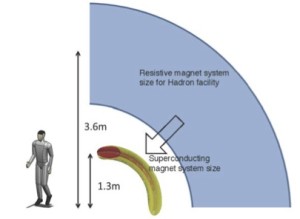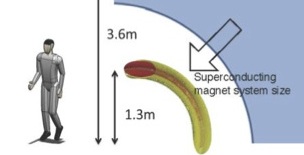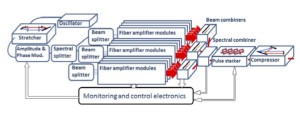This week, the U.S. Department of Energy and the National Cancer Institute announced several research grants for innovation in particle-beam therapies for cancer treatment and laser technology. These grants focus on particle beam-based therapies that hold promise for targeting cancerous tumors while avoiding damage to surrounding healthy tissue and on building faster more powerful lasers for accelerators. Researchers from the DOE’s Lawrence Berkeley National Lab (Berkeley Lab) are participating in two out of six grants awarded as part of the DOE Office of Science Accelerator Stewardship program.

Size comparison between current magnet technology and proposed superconducting magnet technology. Credit: Berkeley Lab
The first grant provides $1.95 million over three years to develop lightweight superconducting magnet technology to reduce the size and weight of particle beam delivery systems by an order of magnitude. This work is a collaboration between Berkeley Lab, the Paul Scherrer Institute in Switzerland, and Varian Particle Therapy, Inc. of Palo Alto. The team will use technologies previously developed for the magnets of the Large Hadron Collider to build and test a prototype designed specifically for cancer treatment. The Berkeley Lab team will be led by Soren Prestemon of Engineering Division and David Robin from the Accelerator Technology and Applied Physics Division (ATAP).
“The Stewardship funding provides an exceptional opportunity to apply expertise and innovations from LBNL in areas of accelerator technology, in particular superconducting magnets and beam optics, in support of particle beam therapy,” says Soren Prestemon, division deputy for ATAP.
David Robin, senior scientist and ATAP program head for Advanced Light Source Accelerator Physics adds: “We expect our more compact, novel superconducting magnets will dramatically improve access to, and quality of, particle beam therapy for the public in the future.”
Another Berkeley Lab team, led by Wim Leemans of ATAP, in collaboration with Jay Dawson’s team at Lawrence Livermore National Laboratory and the Almantas Galvanauskas team at the University of Michigan, will test and advance technologies for laser-based accelerators. The goal is to increase laser pulse speeds 100 to 1000 times and thereby increase the typical average power level from the tens of watt to the multi-kilowatt level. This type of laser, known as an ultra-fast laser, will be used in an emerging class of particle accelerators (See “World Record for Compact Particle Accelerator”) that promise to be small enough to fit on a tabletop. The grant provides $2.35 million over three years.
“With the Stewardship funding, we have the potential to explore concepts that can revolutionize the way lasers are built, opening up a variety of applications,” says Leemans, director of ATAP. “These high average and high peak power, ultrafast lasers will in turn underpin the revolutionary new accelerator and light sources we are working on at LBNL and other institutions around the world.”
“We are delighted that the Stewardship Program is under way and that we received two of the grants”, says James Symons, Associate Laboratory Director for Physical Sciences. “Berkeley Lab was one of the original innovators in particle beam therapy,” Symons adds, “making it especially pleasing that we are able to apply state-of-the-art superconducting magnet technology to improving the effectiveness of these facilities.”
Read more about the DOE and NCI grants here and here.
###
Lawrence Berkeley National Laboratory addresses the world’s most urgent scientific challenges by advancing sustainable energy, protecting human health, creating new materials, and revealing the origin and fate of the universe. Founded in 1931, Berkeley Lab’s scientific expertise has been recognized with 13 Nobel prizes. The University of California manages Berkeley Lab for the U.S. Department of Energy’s Office of Science. For more, visit www.lbl.gov.

